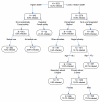Malaria in central Vietnam: analysis of risk factors by multivariate analysis and classification tree models
- PMID: 18234102
- PMCID: PMC2267804
- DOI: 10.1186/1475-2875-7-28
Malaria in central Vietnam: analysis of risk factors by multivariate analysis and classification tree models
Abstract
Background: In Central Vietnam, forest malaria remains difficult to control due to the complex interactions between human, vector and environmental factors.
Methods: Prior to a community-based intervention to assess the efficacy of long-lasting insecticidal hammocks, a complete census (18,646 individuals) and a baseline cross-sectional survey for determining malaria prevalence and related risk factors were carried out. Multivariate analysis using survey logistic regression was combined to a classification tree model (CART) to better define the relative importance and inter-relations between the different risk factors.
Results: The study population was mostly from the Ra-glai ethnic group (88%), with both low education and socio-economic status and engaged mainly in forest activities (58%). The multivariate analysis confirmed forest activity, bed net use, ethnicity, age and education as risk factors for malaria infections, but could not handle multiple interactions. The CART analysis showed that the most important risk factor for malaria was the wealth category, the wealthiest group being much less infected (8.9%) than the lower and medium wealth category (16.6%). In the former, forest activity and bed net use were the most determinant risk factors for malaria, while in the lower and medium wealth category, insecticide treated nets were most important, although the latter were less protective among Ra-glai people.
Conclusion: The combination of CART and multivariate analysis constitute a novel analytical approach, providing an accurate and dynamic picture of the main risk factors for malaria infection. Results show that the control of forest malaria remains an extremely complex task that has to address poverty-related risk factors such as education, ethnicity and housing conditions.
Figures
Similar articles
-
Low perception of malaria risk among the Ra-glai ethnic minority in south-central Vietnam: implications for forest malaria control.Malar J. 2010 Jan 20;9:23. doi: 10.1186/1475-2875-9-23. Malar J. 2010. PMID: 20089152 Free PMC article.
-
Epidemiology of forest malaria in Central Vietnam: the hidden parasite reservoir.Malar J. 2015 Feb 19;14:86. doi: 10.1186/s12936-015-0601-y. Malar J. 2015. PMID: 25880664 Free PMC article.
-
Social determinants of long lasting insecticidal hammock use among the Ra-glai ethnic minority in Vietnam: implications for forest malaria control.PLoS One. 2012;7(1):e29991. doi: 10.1371/journal.pone.0029991. Epub 2012 Jan 12. PLoS One. 2012. PMID: 22253852 Free PMC article.
-
Epidemiology of forest malaria in central Vietnam: a large scale cross-sectional survey.Malar J. 2005 Dec 8;4:58. doi: 10.1186/1475-2875-4-58. Malar J. 2005. PMID: 16336671 Free PMC article.
-
Long-Lasting Insecticidal Hammocks for controlling forest malaria: a community-based trial in a rural area of central Vietnam.PLoS One. 2009 Oct 7;4(10):e7369. doi: 10.1371/journal.pone.0007369. PLoS One. 2009. PMID: 19809502 Free PMC article. Clinical Trial.
Cited by
-
Partial mitochondrial DNA sequences suggest the existence of a cryptic species within the Leucosphyrus group of the genus Anopheles (Diptera: Culicidae), forest malaria vectors, in northern Vietnam.Parasit Vectors. 2010 Apr 30;3:41. doi: 10.1186/1756-3305-3-41. Parasit Vectors. 2010. PMID: 20433694 Free PMC article.
-
Low perception of malaria risk among the Ra-glai ethnic minority in south-central Vietnam: implications for forest malaria control.Malar J. 2010 Jan 20;9:23. doi: 10.1186/1475-2875-9-23. Malar J. 2010. PMID: 20089152 Free PMC article.
-
Epidemiology of forest malaria in Central Vietnam: the hidden parasite reservoir.Malar J. 2015 Feb 19;14:86. doi: 10.1186/s12936-015-0601-y. Malar J. 2015. PMID: 25880664 Free PMC article.
-
Study protocol: an open-label individually randomised controlled trial to assess the efficacy of artemether-lumefantrine prophylaxis for malaria among forest goers in Cambodia.BMJ Open. 2021 Jul 7;11(7):e045900. doi: 10.1136/bmjopen-2020-045900. BMJ Open. 2021. PMID: 34233975 Free PMC article.
-
Malaria and the mobile and migrant population in Cambodia: a population movement framework to inform strategies for malaria control and elimination.Malar J. 2015 Jun 20;14:252. doi: 10.1186/s12936-015-0773-5. Malar J. 2015. PMID: 26088924 Free PMC article.
References
-
- Claudio Schuftan A story to be shared: the successful fight against malaria in Vietnam. WHO WPRO and the global Roll Back Malaria Programme. 2000. http://www.afronets.org/files/malaria.pdf
-
- Barat LM. Four malaria success stories: how malaria burden was successfully reduced in Brazil, Eritrea, India, and Vietnam. Am J Trop Med Hyg. 2006;74:12–16. - PubMed
-
- NIMPE . Annual Report of the National Malaria Control Program in Vietnam. Hanoi; 2004.
Publication types
MeSH terms
Substances
LinkOut - more resources
Full Text Sources
Medical


